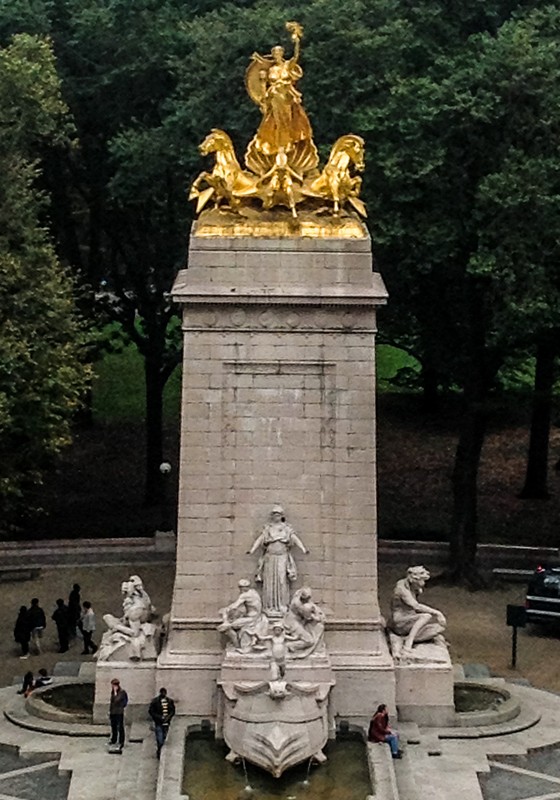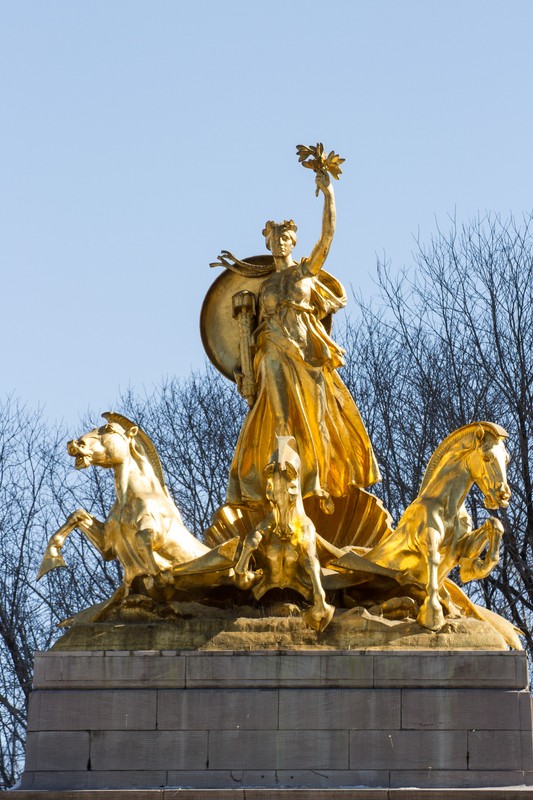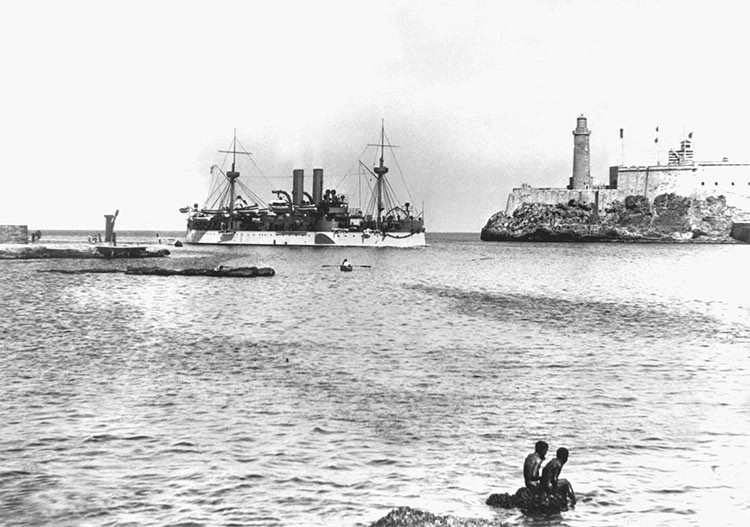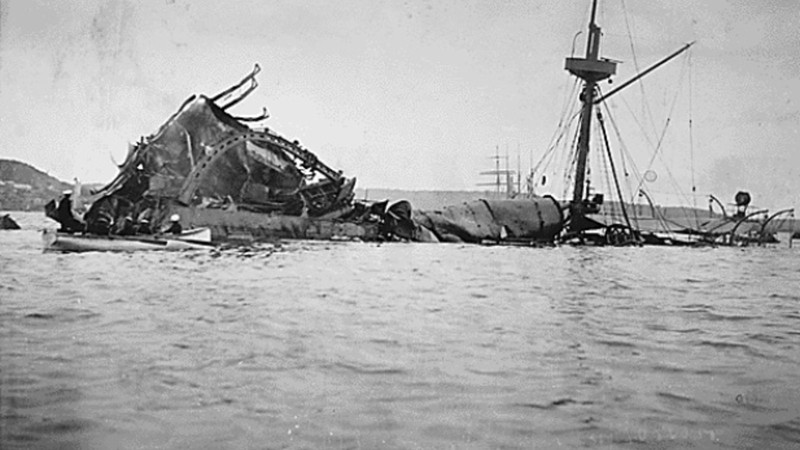The U.S.S. Maine National Monument
Introduction
Text-to-speech Audio
Images
The U.S.S. Maine National Monument

A close-up of the gilded bronze statue atop the monument

The U.S.S. Maine entering Havana Harbor in January 1898

The wreckage of the U.S.S. Maine

Backstory and Context
Text-to-speech Audio
By 1898, Spain’s overseas empire was a shadow of its former self. Throughout the nineteenth century, independence movements chipped away at the once vast, powerful empire that stretched from modern-day California to the Caribbean and from present-day Florida to the southern tip of South America. This wave of nationalist uprisings reached Cuba in 1868, when Cuban insurgents frustrated with Spanish rule declared the island independent and fought a spirited, but ultimately unsuccessful ten-year guerilla war with Spain. In 1895, the Cuban struggle for independence resumed.
The events unfolding on the Caribbean island caught the attention of the U.S. government, big business, and the American people. A brutal guerilla war in which Cuban insurgents focused on targets of economic value, such as sugar mills and plantations, not only threatened American investments in Cuba, which were estimated at about $50 million, but also disrupted commerce between the United States and Cuba, which was valued at roughly $100 million annually. In the United States, the yellow press (publications that often sensationalized the news in order to sell newspapers) ran stories on Spanish cruelty. In particular, they focused on the Spanish practice of rounding up Cuban civilians and forcing them to live in detention camps, where many died from starvation, disease, and exposure. These reports tugged at the heartstrings of Americans and increased public support for American intervention. Finally, Spain’s inability to quell the rebellion along with its reluctance to give in and grant Cuba its independence allowed the bloody conflict to drag on for years and garner the attention of the U.S. government.
In December 1897, riots rocked the city of Havana, compelling President William McKinley and Congress to send a battleship, the U.S.S. Maine, to Havana Harbor to protect American citizens and property. A few months later, on February 9, 1898, the New York Journal printed a letter written by Spain’s minister in Washington, D.C., Enrique Dupuy de Lôme, in which he characterized President McKinley as weak. Four days later, on the evening of February 15, an explosion destroyed the U.S.S. Maine, killing nearly 270 American sailors. An investigation by the U.S. Navy concluded that an external explosion probably caused by a mine ignited the vessel’s forward magazine. Despite the fact that the investigation could not determine exactly who was responsible for the tragedy, the yellow press in the United States pointed to Spain and rallied public support for American intervention with the slogan, “Remember the Maine, to hell with Spain!” Impelled by growing public support for American intervention in Cuba, President McKinley asked Congress to draft a series of resolutions. One resolution authorized President McKinley to use military force to end the conflict in Cuba, while another demanded that Spain relinquish its authority over Cuba and withdraw its military forces from the island. When Spain heard of the passage of the resolutions, it severed diplomatic relations with the United States and declared war on April 24. The following day, the United States declared war on Spain.
In the war that followed, the United States scored an overwhelmingly decisive victory. Unprepared and ill-equipped to fight a war against an emerging world power, Spain’s military forces simply proved no match for those of the United States. The fighting lasted roughly four months and resulted in less than 400 American combat deaths, prompting U.S. Secretary of State John Hay to dub it a “splendid little war.” As a result of its victory over Spain, the United States acquired Guam, the Philippines, and Puerto Rico, and Cuba achieved its independence.
Only a few days after the U.S.S. Maine exploded in Havana Harbor, New York newspaper publisher William Randolph Hearst began soliciting donations for a memorial to honor the nearly 270 American sailors who lost their lives. Architect H. Van Buren Magonigle and sculptor Attilio Piccirilli were commissioned to design and build it. Located in Merchants’ Gate Plaza at Central Park’s southwestern entrance, the monument consists of a large granite pylon topped with a gilded bronze female figure, Columbia Triumphant, riding in a seashell chariot pulled by three hippocampi. The bronze used for the statue was reportedly recovered from the guns of the sunken battleship. At the base of the pylon is a fountain and several marble figures that symbolize the Atlantic and Pacific Oceans, along with the ideas of courage, fortitude, justice, war, and peace. The monument was dedicated on May 30, 1913.
Cite This Entry
Curran, Francis. "The U.S.S. Maine National Monument." Clio: Your Guide to History. October 29, 2020. Accessed March 18, 2025. https://theclio.com/tour/463/30/reverse
Sources
"Maine Monument." Central Park Conservancy. Web. 19 October 2020 <https://www.centralparknyc.org/locations/maine-monument>.
"Spanish-American War." Encyclopaedia Britannica. Web. 19 October 2020 <https://www.britannica.com/event/Spanish-American-War>.
"The U.S.S. Maine National Monument." New York City Department of Parks and Recreation. The City of New York. Web. 19 October 2020 <https://www.nycgovparks.org/parks/central-park/highlights/12813>.
https://www.centralparkinbronze.com/u-s-s-maine-national-monument
https://www.centralparkinbronze.com/u-s-s-maine-national-monument
https://www.historytoday.com/archive/sinking-maine
https://www.cfr.org/blog/twe-remembers-sinking-uss-maine

